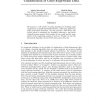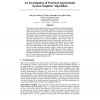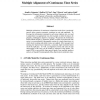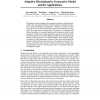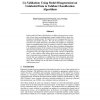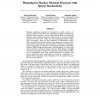NIPS
2004
15 years 2 months ago
2004
We propose a "soft greedy" learning algorithm for building small conjunctions of simple threshold functions, called rays, defined on single real-valued attributes. We al...
114
click to vote
NIPS
2004
15 years 2 months ago
2004
This paper concerns approximate nearest neighbor searching algorithms, which have become increasingly important, especially in high dimensional perception areas such as computer v...
NIPS
2004
2004
Methods for Estimating the Computational Power and Generalization Capability of Neural Microcircuits
15 years 2 months ago
What makes a neural microcircuit computationally powerful? Or more precisely, which measurable quantities could explain why one microcircuit C is better suited for a particular fa...
120
click to vote
NIPS
2004
15 years 2 months ago
2004
Multiple realizations of continuous-valued time series from a stochastic process often contain systematic variations in rate and amplitude. To leverage the information contained i...
128
Voted
NIPS
2004
15 years 2 months ago
2004
This paper presents an adaptive discriminative generative model that generalizes the conventional Fisher Linear Discriminant algorithm and renders a proper probabilistic interpret...
NIPS
2004
15 years 2 months ago
2004
Bayesian Regularization and Nonnegative Deconvolution (BRAND) is proposed for estimating time delays of acoustic signals in reverberant environments. Sparsity of the nonnegative f...
107
Voted
NIPS
2004
15 years 2 months ago
2004
Most existing tracking algorithms construct a representation of a target object prior to the tracking task starts, and utilize invariant features to handle appearance variation of...
105
click to vote
NIPS
2004
15 years 2 months ago
2004
In the context of binary classification, we define disagreement as a measure of how often two independently-trained models differ in their classification of unlabeled data. We exp...
NIPS
2004
15 years 2 months ago
2004
NIPS
2004
15 years 2 months ago
2004
We propose a new method for estimating intrinsic dimension of a dataset derived by applying the principle of maximum likelihood to the distances between close neighbors. We derive...
